PICTURES
"HO CHI MINH CITY" (SAIGON) -- "SIEM REAP" --
"ANGKOR WAT" -- "PHNOM PENH" --
"SIHANOUKVILLE"
September 2006
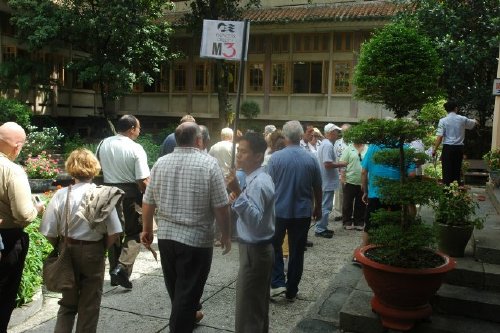 |
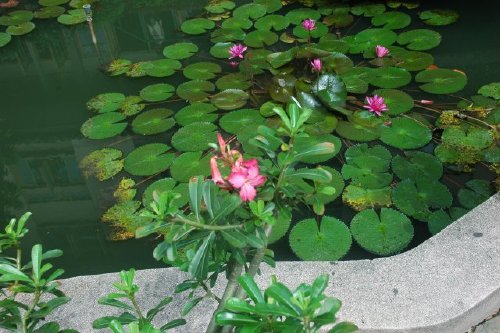 |
Our tour of Ho Chi Minh City (Saigon) began with a trip to a puppet show. All Asian countries have some variation of puppets and love to show them off. This is the entrance to the theatre and you can tell that we are group M3. Gawd I hate large group tours!!!! |
As you walk in, you walk over a bridge that has pools of water lilies on both sides. They say in this area, if you throw a seed down anywhere, it will grow ... these were sure luxuriant |
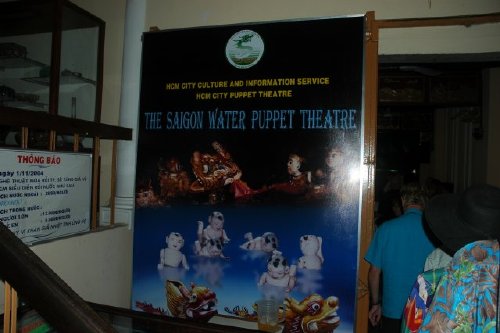 |
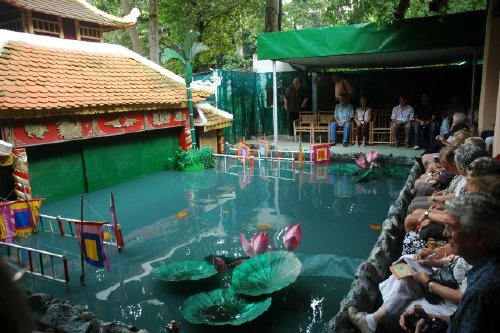 |
We really had no idea what to expect ... but a puppet show ??? |
The pool was about 50 feet wide and 40 feet deep, with the curtains at the back. |
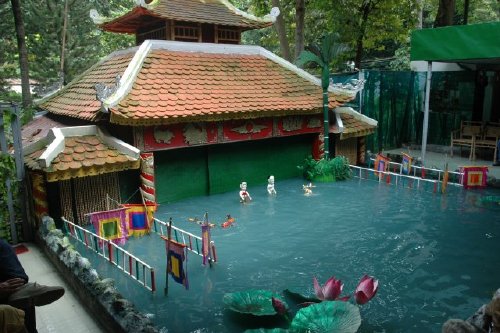 |
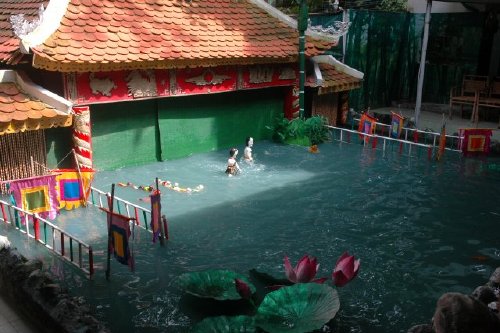 |
The theme was based upon a love story that we could not follow too well, but the puppets moved back and forth in the water and even crossed in front of one another. |
There were all together about 25 different puppets with sometimes more than 15 out performing at once |
 |
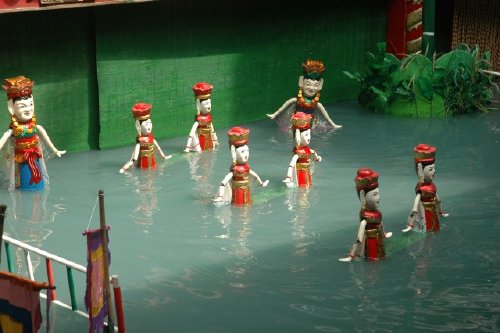 |
It was quite interesting as everyone was curious as to just how all this was accomplished |
The costumes were quite well done also |
 |
 |
These are the puppeteers ... now let's see ... 6 people = 12 hands ... Hmmm .. yet they had 15 puppets working at the same time ... turns out that some of the puppets are foot operated... sort of like rubbing your stomach and patting your head at the same time... too challenging for the likes of me! |
The audience was quite appreciative. The total performance was about 20 minutes and synched with music. Quite neat really ... |
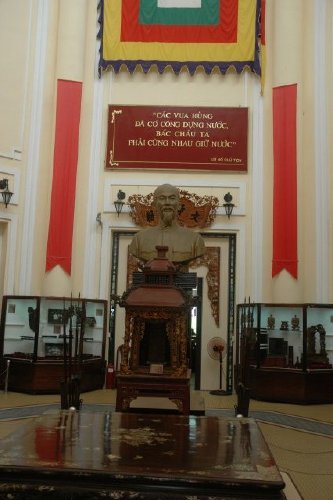 |
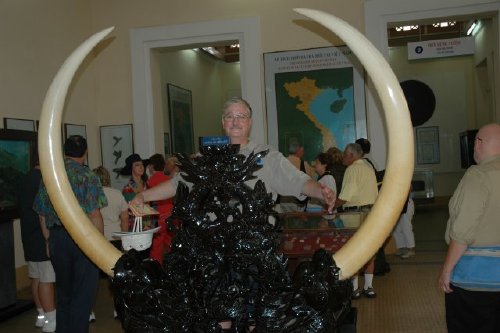 |
| There was a Natural History Museum attached to the water puppets ... or was the puppets attached to the Museum ... Hmmm ... Anyway, the main site as you walked in is this very large carving of Ho Chi Minh. .....Natural History ???? | They had some pretty big animals around here ... tusk tusk ... what a ham!!!! |
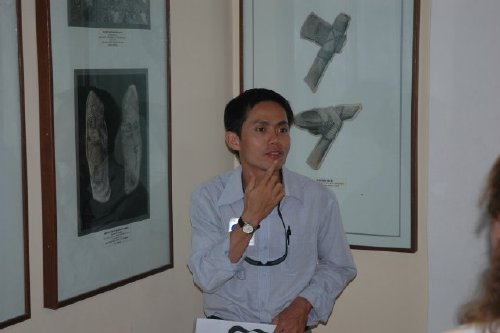 |
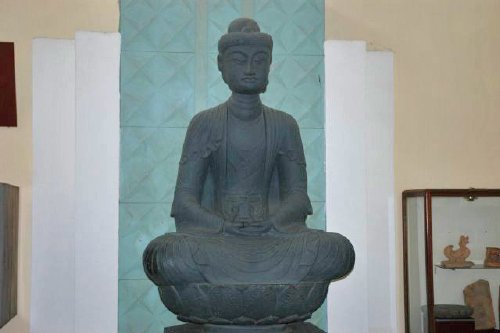 |
The guide of M3 answering questions for whom ever was left of the huge group Frustration at group sizes sure has people wandering away. The personal guide service we had in India sure spoiled us!!! |
Buddha carved from a solid piece of jade ... |
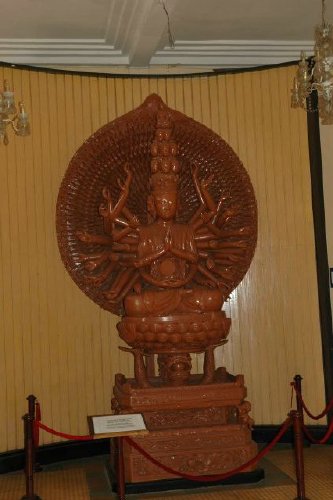 |
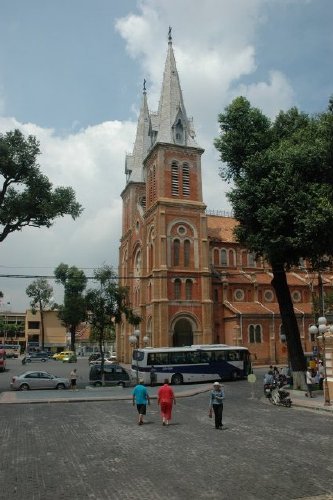 |
Sure a lot of beautifully carved, intricate pieces |
A very large, old, Catholic Church across from the Post Office Tower in the downtown area. The Church still stands even though the Communists had banned religion. Interesting ... we did not get inside it though ... I don't know why??? |
 |
 |
As the economy here in the South increases, less pedal bikes and more motor scooters. Cars, of course, will come and when that happens ... look out for grid lock! Right now, thousands can use the existing roads on bikes, but if the bikes were all cars ... |
Notice the bike on the side walk ... OK as long as no one is hurt |
 |
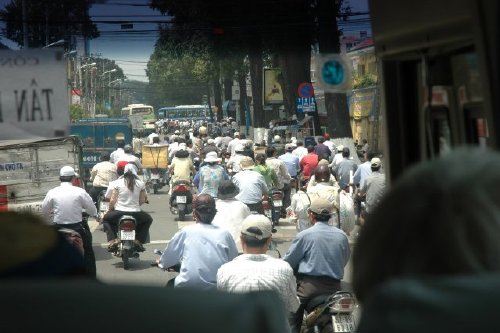 |
Notice how clean the streets are .. Compared to India ..... WOW |
This is not rush hour, it is the middle of the day |
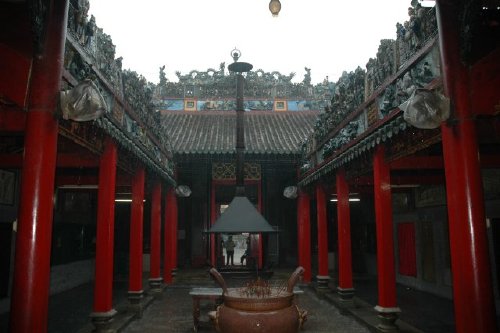 |
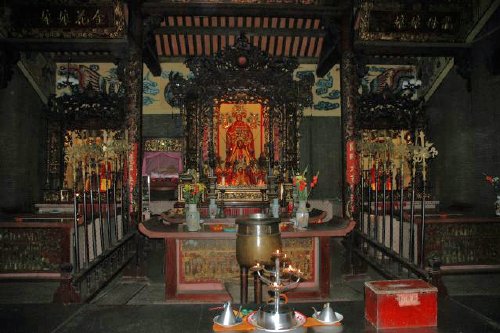 |
It started to rain heavily. Remember that the temperatures are in the mid to high 30's so rain only gets you wet. If you put on one of the plastic coats they give you, you only sweat enough so you are soaked anyway. This was the paradox that we had to face fro the next 4 days. Sun, then rain, then sun ... can you imagine the humidity??? |
The largest Buddhist Temple in Saigon. Very ornate and full of golden objects. Unfortunately, some of the temple is open to the air ... see last picture ... so all the huge tour group tries to huddle under covered sections. |
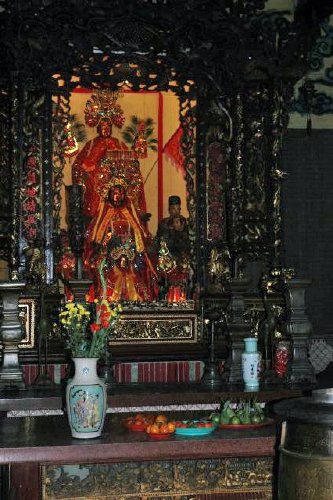 |
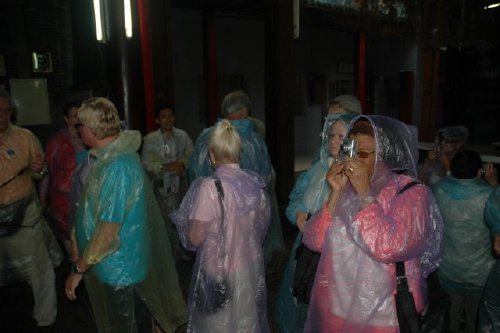 |
You feel a little strange wandering around, taking pictures and talking in an operating temple. The locals seem to be very tolerant about that though |
As I say, free plastic coats means sweating ... Elsie and I didn't bother .. I guess being from the "Wet Coast" we are more used to the rain and realized that we wouldn't melt |
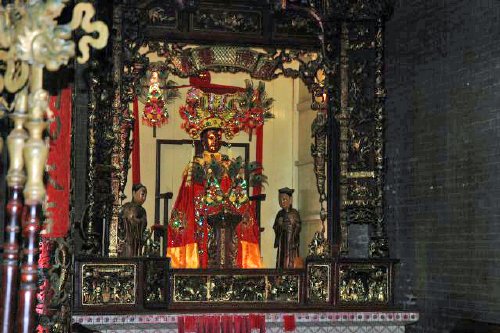 |
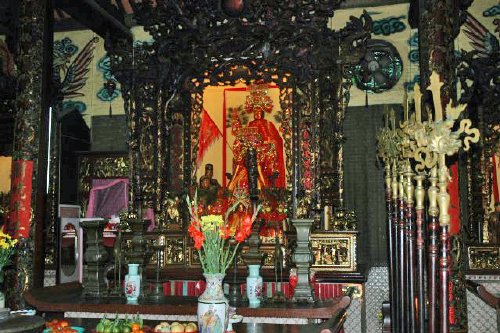 |
The colours makes the place shine ... |
We spent about an hour here and the time seemed to slip by quickly |
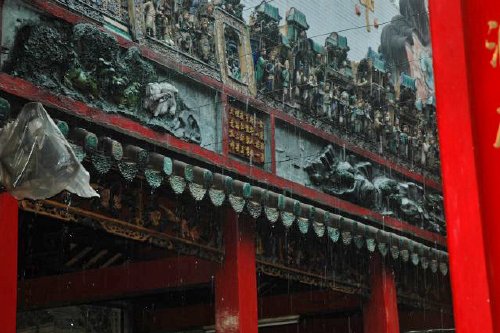 |
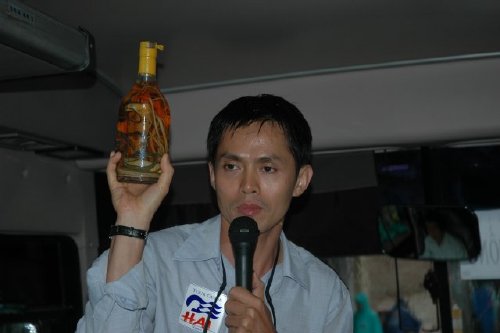 |
This is the fringe around the inner courtyard. Beautiful carvings in solid stone |
Now this bears an explanation ... a younger couple from eastern US asked the guide if the bus could stop for some Vietnam "special" wine. For $5.00 US you got a normal size bottle and for $10.00 US you got a one litre bottle of what looked like a rose type of wine. The special part was that it included a dead cobra inside the bottle. Now the Mexicans have a worm in their tequila but a full sized dead snake sort of topped everything. We were told that 1/2 the venom was removed and what was left was supposed to help cure arthritis and works as an aphrodisiac. I'll bet eh..... Considering that in the countryside today there are still lots of deaths from these snakes, I thought we wouldn't buy one ...besides, I would hate to try to explain to the US Customs why I was taking this home. |
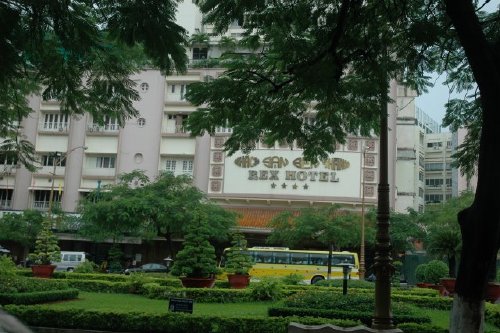 |
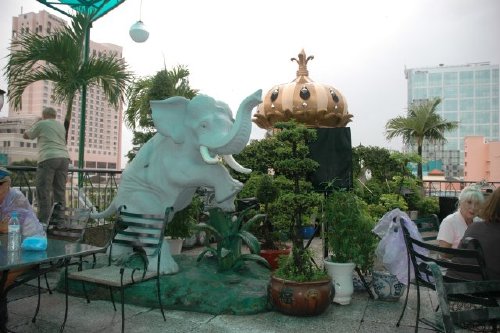 |
| The Rex stands as a monument to Saigon's recent history. Originally a French garage, it later became a hotel and then the base for American operations during the Vietnam War. Its conference room was the scene of the "five o'clock follies" -- daily press briefings to journalists. | During the Vietnam War, the Rex Hotel was a favorite watering hole for American officers. Renovations have seen it return to some of its former splendor. Many of the city's best shops and restaurants are within easy walking distance. The hotel also has three restaurants, including the famous Rooftop Garden where you can enjoy a drink or a meal overlooking the busy streets below. |
 |
 |
The rooftop was the site of what was once known as the Sai Gon Follies, daily press conferences during the war |
The weather alternated form rain to sun and back again ... all with the humidity approaching 100% |
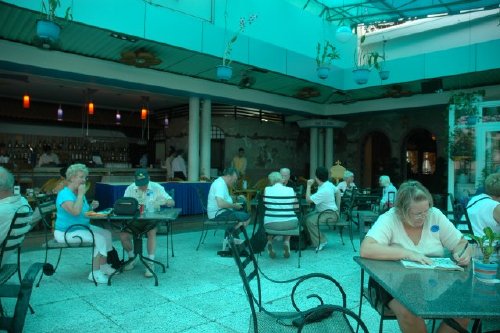 |
 |
Can you picture all the CBS, NBC, ABC "biggies" sitting here and writing the reports to send to the States during the war? Wait a sec ... isn't that Walter C sitting over there?? or is it Dan Rather???? |
The colour is a little blue here because of the blue fiber glass covering to keep out the rain |
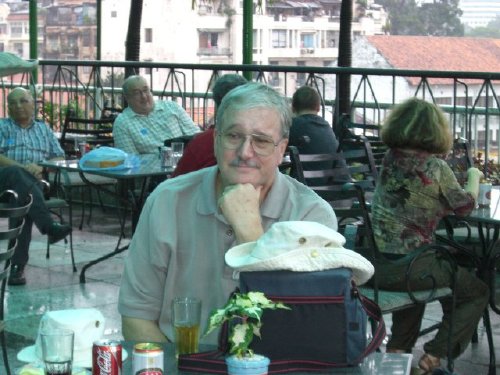 |
 |
A quiet reflective moment ... It is about 4:00 PM here and we are waiting for the bus to take us to the airport to head to Siem Reap Cambodia ... We have been up for hours and all I would like to do is dry off!!! |
Everyone drives motor scooters ... but still the traffic works here |
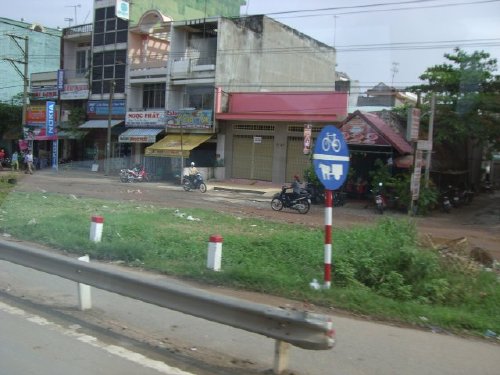 |
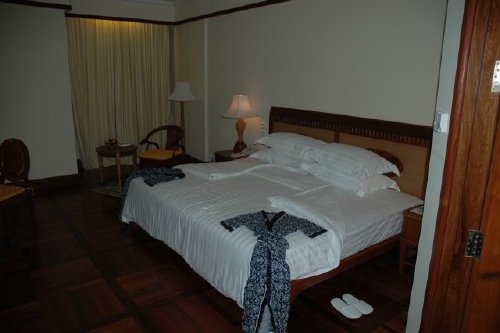 |
I love the traffic sign here ... |
The hotel in Siem Reap is truly 5 star!!!! There is more room here in this place than what we live in with Harvey. Don't you love the dressing gown and slippers? |
 |
 |
The bathroom was huge ... it is bigger than our stateroom on the ship |
All this in a country where most citizens live on a couple of hundred dollars a year |
 |
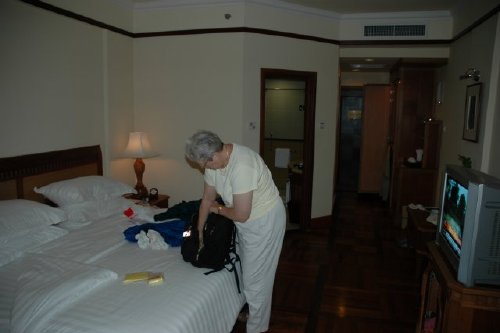 |
We are here in this spot for two nights so, of course, Elsie unpacks everything. Fortunately, she left most of our stuff on the ship and only packed the essentials |
But, the essentials still take time to unpack |
 |
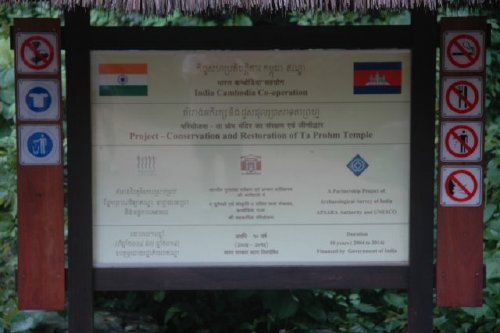 |
| Nestled between rice paddies and stretched along the Siem Reap River, the small provincial capital of Siem Reap Town serves as the gateway to the millennium-old temple ruins of the Khmer Empire. Designated a World Heritage Site by UNESCO, the Angkor Archaeological Park encompasses dozens of temple ruins including Bayon, Banteay Srey and the legendary Angkor Wat whose artistic and archaeological significance and visual impact put it in a class with the Pyramids, Machu Pichu and the Taj Mahal. |
The welcome sign to Ta Prohm Temple complete with the international "what not to do signs" |
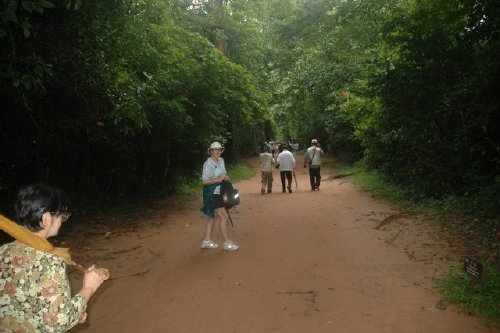 |
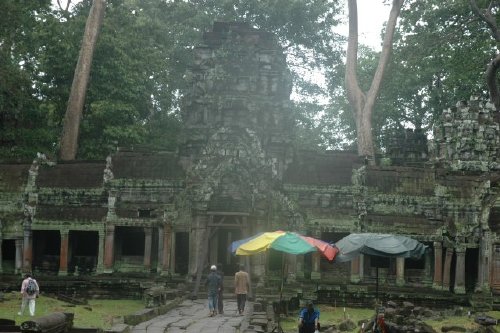 |
The path to the temple was about 1/4 mile from the parking lot. Here the rain has stopped for the moment .... |
Ta Prohm Temple is a quiet, sprawling monastic complex only partially cleared of jungle overgrowth. Intentionally left partially un restored, massive fig and silk-cotton trees grow from the towers and corridors offering some of the best ‘tree-in-temple’ photo opportunities at Angkor. Flocks of noisy parrots flit from tree to tree adding to the jungle atmosphere. This temple was one of Jayavarman VII's first major temple projects. Ta Prohm was dedicated to his mother; Preah Khan, built shortly after Ta Prohm in the same general style, was dedicated to Jayavarman VII’s father. Ta Prohm was originally constructed as a Buddhist monastery and was enormously wealthy in its time, boasting of control over 3000 villages, thousands of support staff and vast stores of jewels and gold. |
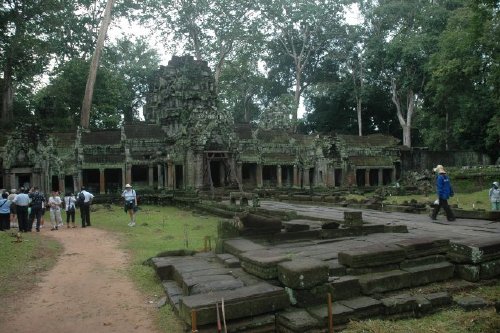 |
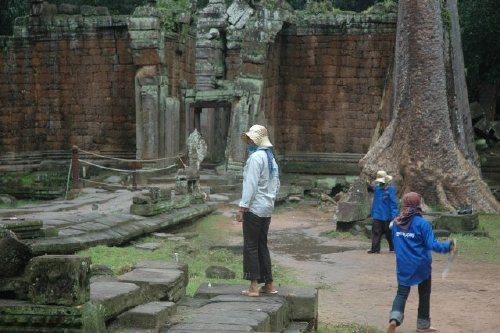 |
Ta Prohm is located some 2 kilometers east of Angkor Thom. Dedicated to Jayavarman's mother, this most romantic of Angkor temples was a double-moated royal monastery that once housed more than 12,000 people. Ta Prohm has been "left as it was found" and today the slow encroachment of the jungle continues to take place; it is one of the few places at Angkor where the visitor can experience the site somewhat as it appeared in the 19th century, when it was first discovered by European explorers. |
Lots of people work here to keep back the jungle! |
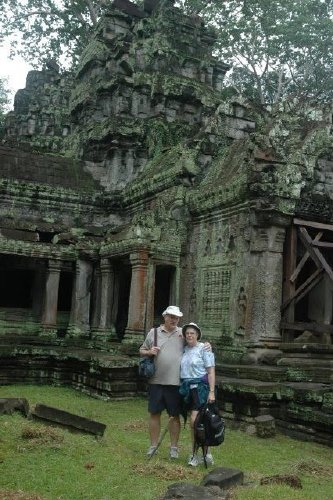 |
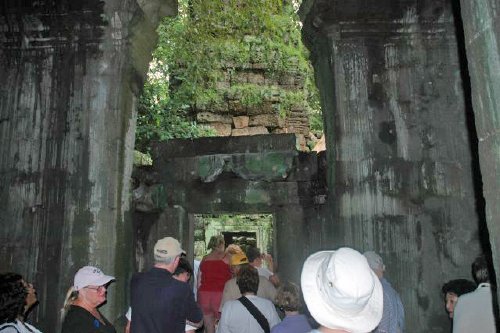 |
It was raining slightly here...the intrepid soaked travelers... the Temple looks spooky with the moss covering. They say if you drop a seed anywhere in Cambodia, it will grow ... and boy do I believe that... jungle climate |
With a good imagination, you can picture what it must have looked like 500 years ago |
 |
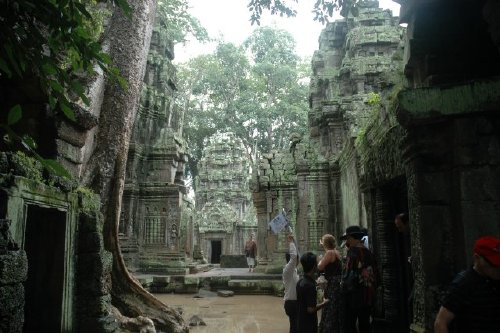 |
Unlike other temples at Angkor, Ta Prohm has been left as it was found, preserved as an example of what a tropical forest will do to an architectural monument when the protective hands of humans are withdrawn. Ta Prohm's walls, roofs, chambers and courtyards have been sufficiently repaired to stop further deterioration, and the inner sanctuary has been cleared of bushes and thick undergrowth, but the temple has been left in the stranglehold of trees. Having planted themselves centuries ago, the tree's serpentine roots pry apart the ancient stones and their immense trunks straddle the once bustling Buddhist temple. Built in the later part of the 12th century by Jayavarman VII, Ta Prohm is the terrestrial counterpart of the star Eta Draconis the Draco constellation. |
What a great place to film a Halloween movie ... the trees seem to grow right out of the rock walls |
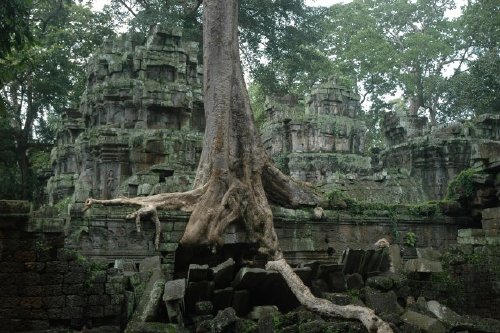 |
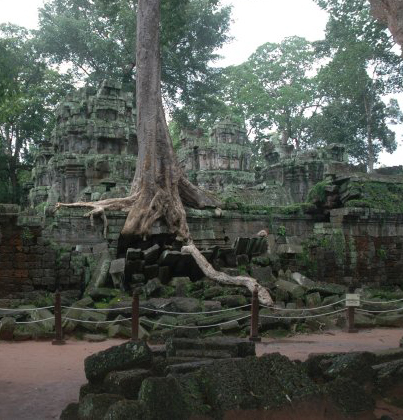 |
As you walk through, it just seems to get more spooky |
You wonder how this tree got started. |
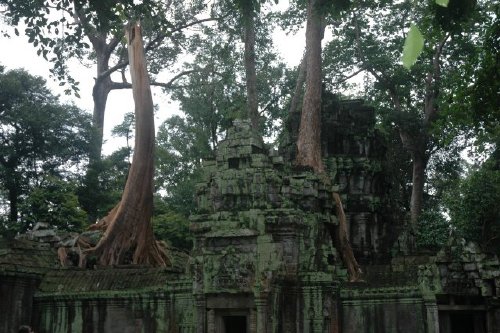 |
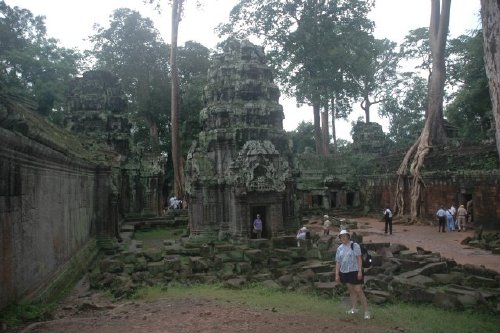 |
Apparently these Temples were forgotten and have just been uncovered in the last century or so |
It really is quite large with smaller Temples within the larger one |
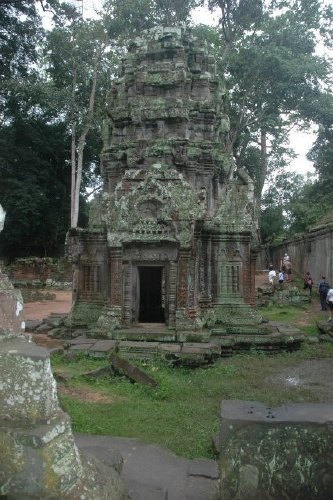 |
 |
Look at the carvings on these walls .. beats the heck out of 16th Century Mogul forts of India |
I think Elsie was looking for a ride here???? |
 |
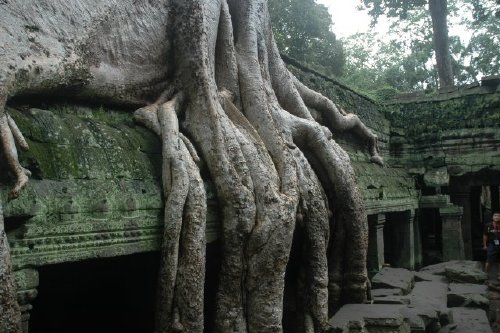 |
This is carved out of a single block of stone and inset as a pillar for the small Temple |
Looks like molten lava pouring over the walls |
 |
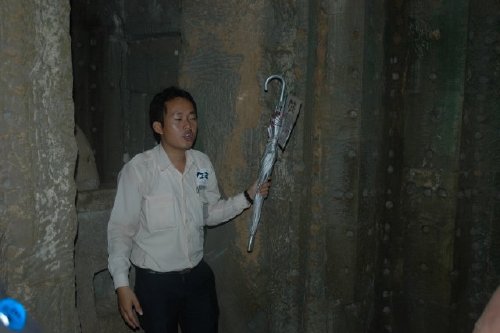 |
These are the workers whose sole job is to hack away at the jungle to keep it from taking over again. The humidity was awful here and I guess it was coffee break? |
The Guide getting into his subject matter. He really was quite good |
 |
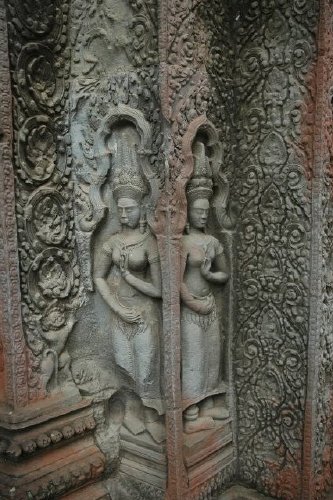 |
They are leaving the trees as they are so you get an idea of what it was like for centuries before someone stumbled on it |
Can you believe the carvings???? |
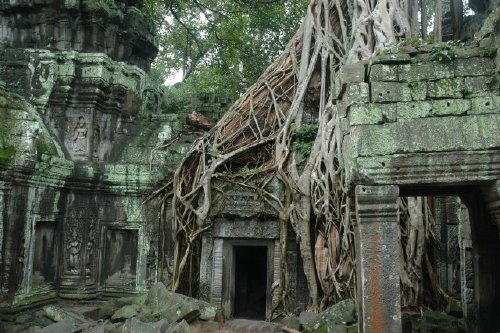 |
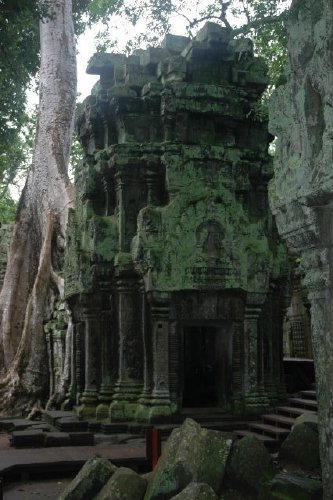 |
Trying to get to the "root" of this would be a real problem eh? |
Moss everywhere ... just how the carvings managed to survive is a puzzle |
 |
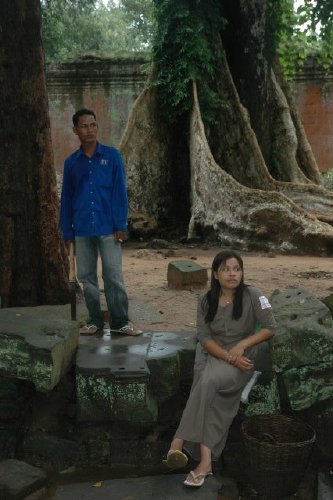 |
More international "Do and Don't" signs ... you have to wear at least a Tee Shirt ... no pants????? |
More workers ... notice the large knife in the man's hand |
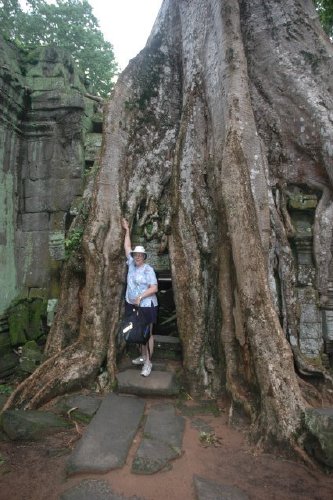 |
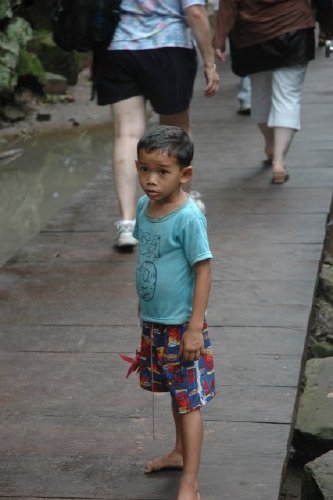 |
Gives you an idea on just how tall these roots grow. How did they start? |
This little guy was selling a bird like thing. But, he was very polite ... not like some of the street hawkers!!!! |
 |
 |
Pulling weeks Cambodia style |
These guys were just standing there in traditional clothing. They are trying to attract more tourists to this area. |
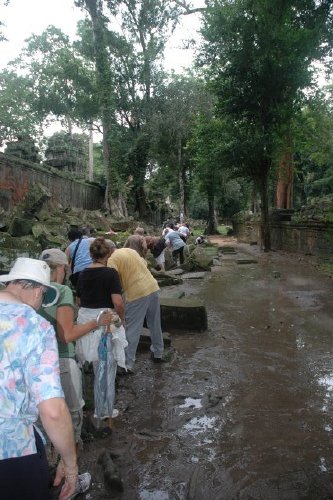 |
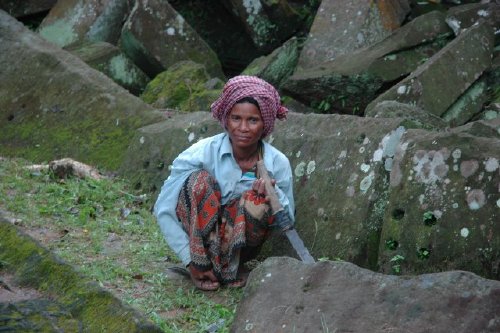 |
Ahhh ... when it rains in the jungle ... |
Another jungle fighter ... the knife she has is about two feet long |
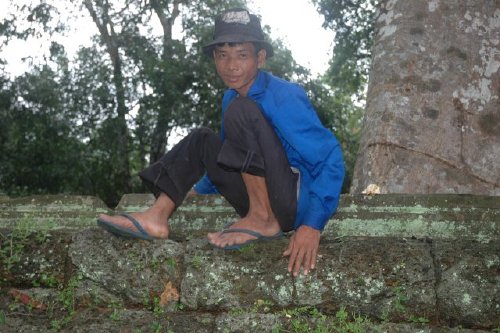 |
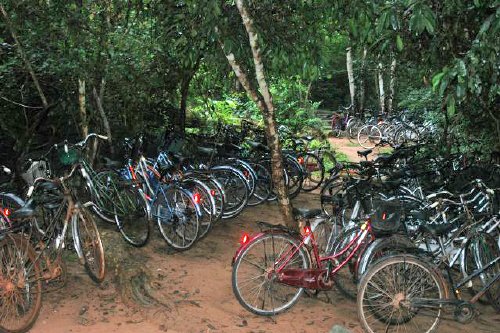 |
He was trying to get the bigger pieces of moss off the wall. |
Employee parking lot |
 |
 |
This group was playing traditional instruments as you enter the Temple. Each player has something in common with all the rest ... they have lost their legs to land mines. Apparently, the borders still are covered with them and between the mines and the cobras the life of a farmer is not a pleasant one. The only way they support themselves is by getting donations here. Makes you stop and think about a lot of things ... we sure do have a great life here in Canada!!!! |
This is the Leper King Terrace Some of the carvings have been cleaned but not all. |
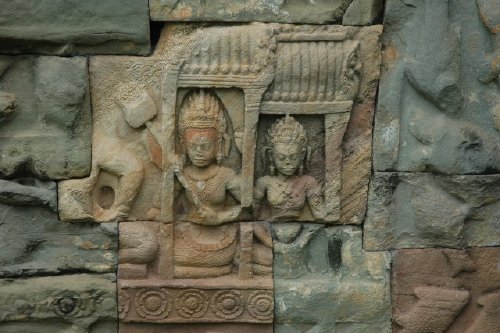 |
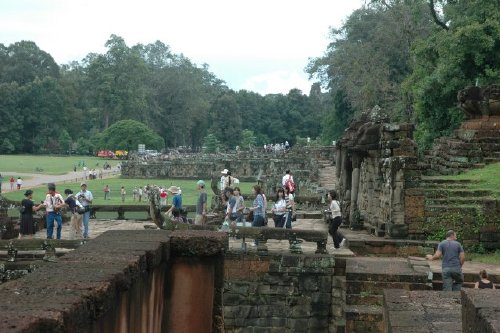 |
The background of the Terrace of the Leper King is shrouded in some degree of mystery. Speculation exists that at least a couple of Angkor's kings could have been lepers. Jayavarman VII, who constructed the Bayon and took the Khmer from Hinduism to Buddhism during his reign, is the leading candidate. But the terrace may be built simply to reflect Hindu legend |
Just under 1000 feet long, the Elephant Terrace is made of carved sandstone; the stairways are buted with three-headed elephants. The carvings portray hunting scenes, with an emphasis on lions and tigers. The Elephant Terrace extends from the Baphuon to the Terrace of the Leper King. It is unclear today as to whether the three structures were connected or whether there was space between them, and, like the Baphuon itself, alterations were evidently made to both terraces. The bas-reliefs of the Elephant Terrace, in addition to the hunting scenes present images of sporting events, including wrestling, chariot races, and a game that, though popular today in Europe, originated in Asia - polo. |
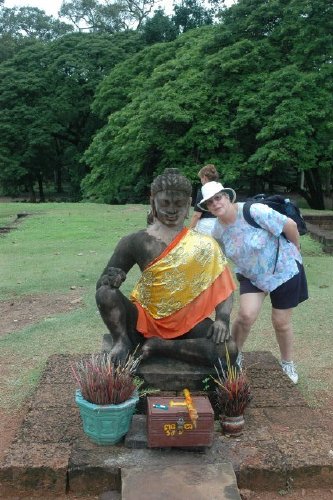 |
 |
| A double terrace at the north end of the Terrace of Elephants with deeply carved nagas, demons and other mythological beings. The terrace was named for the statue of the leper king that sits on top. Why the statue is known as the 'leper king' is less clear. Some argue that when the statue was found, its lichen-eaten condition gave it the appearance of leprosy. Others have argued that it is a statue of the leper king of Khmer legend, or that the condition of the statue inspired its connection to the legend. The model for the statue is also a matter of debate. Suggestions include a couple of different Hindu gods, and the Khmer kings Yasovarman I and Jayavarman VII. Recent scholarship favors a combination of Jayavarman VII and Buddha. The statue of the leper king on display at the terrace is a replica. The original resides in the National Museum in Phnom Penh. | This is beside the Leper King Terrace ... appropriately called the Elephant Terrace ... Elsie and here Elephants!!!! |
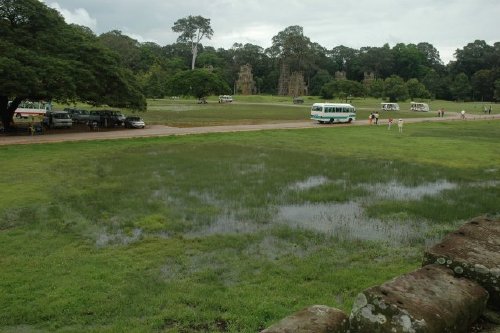 |
 |
Angkor Thom was the last and most enduring capital city of the Khmer empire. It was established in the late twelfth century by king Jayavarman VII. It covers an area of 9 km², within which are located several monuments from earlier eras as well as those established by Jayavarman and his sucessors. At the centre of the city is Jayavarman's state temple, the Bayon, with the other major sites clustered around the Victory Square immediately to the north. |
You can see the standing water here ... this is the end of the monsoon season and in each puddle mosquitoes are breeding ... boy, are we glad that we are not here next month. |
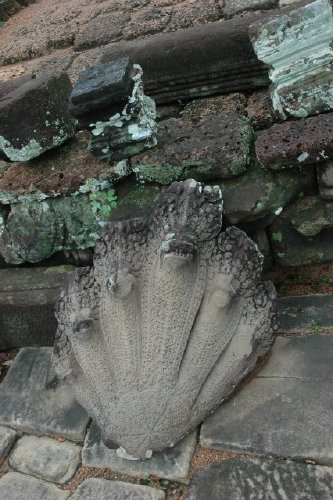 |
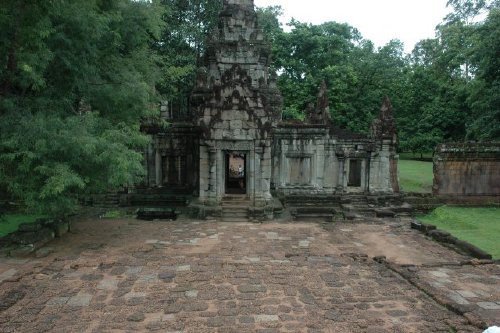 |
The cobra plays a very important role in many of the carvings |
Huge place with buildings everywhere you look |
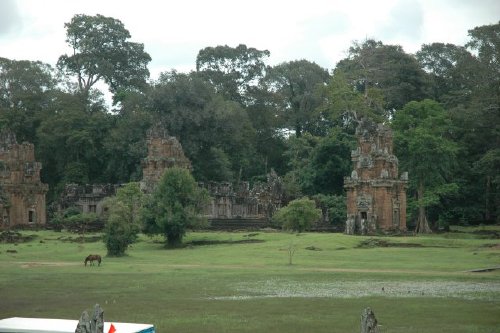 |
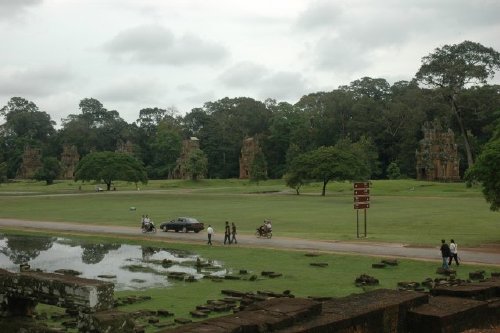 |
Can you imagine what this place must have looked like 500 years ago? |
I can just hear those mosquitoes getting ready |
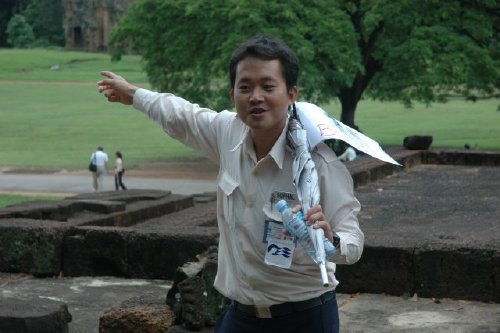 |
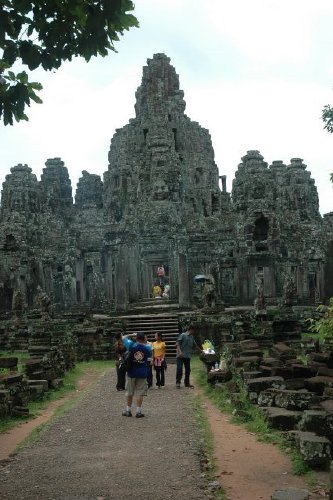 |
Again our guide getting excited about is topic |
The giant stone faces of Bayon have become one of the most recognizable images connected to classic Khmer art and architecture. There are 37 standing towers, most but not all sporting four carved faces oriented toward the cardinal points. Who the faces represent is a matter of debate but they may be Loksvara, Mahayana Buddhism's compassionate Bodhisattva, or perhaps a combination of Buddha and Jayavarman VII. Bayon was the Jayavarman VII's state-temple and in many ways represents the pinnacle of his massive building campaign. It appears to be, and is to some degree, an architectural muddle, in part because it was constructed in a somewhat piecemeal fashion for over a century. |
 |
 |
| The Bayon was the last state temple to be built at Angkor, and the only one to be built primarily as a Mahayana Buddhist temple (although various local deities were also worshipped there). It was the centrepiece of Jayavarman VII's building program, and the similarity of the faces on the temple's towers to other statues of the king have led many scholars to the conclusion that the faces are, at least in part, representations of Jayavarman VII (although Avalokitesvara is another possibility). Under the reign of Jayavarman VIII in the mid-13th century the temple was converted to Hinduism. In later centuries Theravada Buddhism became dominant, before the temple was eventually abandoned to the jungle. Current features which were not part of the original plan include the terrace to the east of the temple, the libraries, the square corners of the inner gallery, and the upper terrace. | |
 |
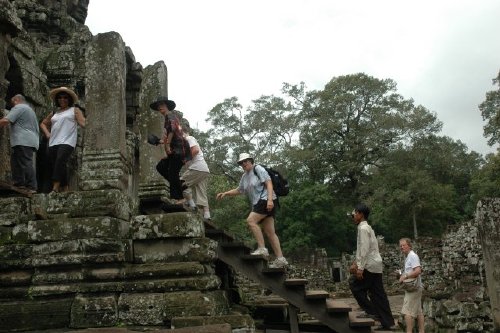 |
Still more steps ... I think over the day here we must have climbed close to 500 steps. Good thing we are in such top shape eh |
|
 |
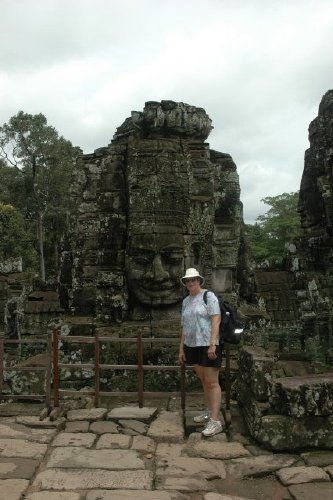 |
This is the scene at the top of the steps ... |
The faces carved into the stone are everywhere |
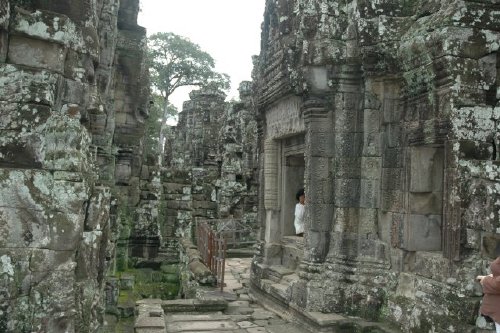 |
 |
This is the entrance to the Buddhist Monk's fortune telling location |
This is not just a monument ... here locals are having the Priest read their fortunes. |
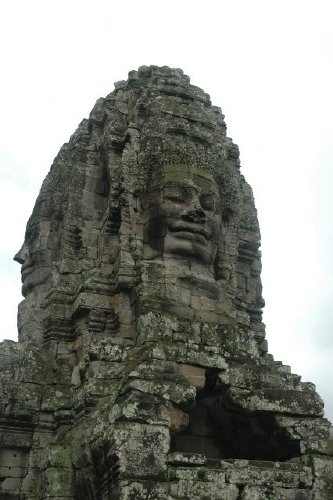 |
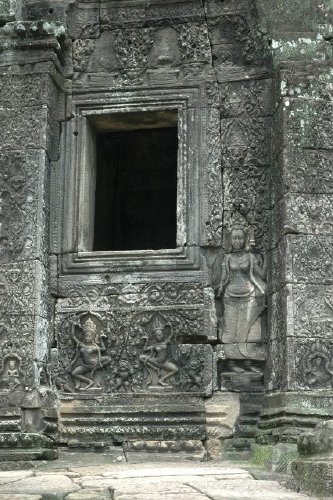 |
This tower has faces on all four sides ... For perspective, that tower is probably 35 feet tall. |
Even the walls are carved |
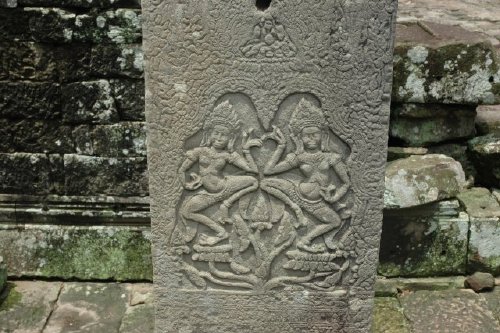 |
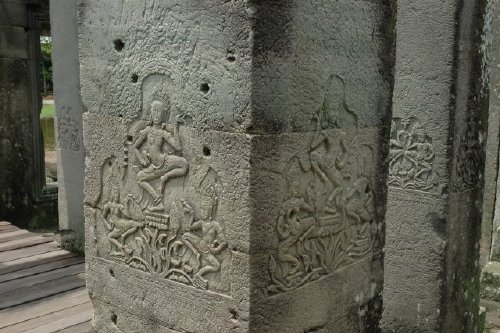 |
They are cleaning some of the carvings so they stand out more |
|
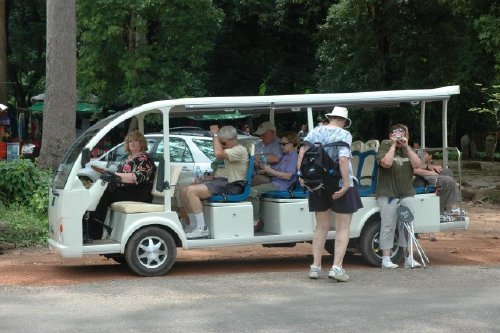 |
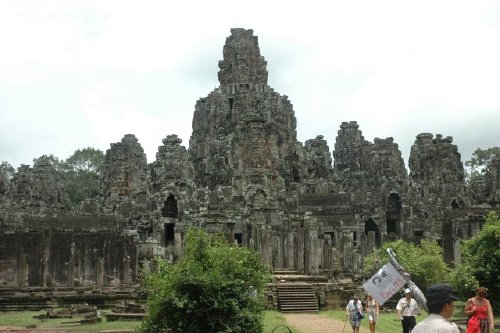 |
Because of the size of the gates to the place, large busses can not make it through so all passengers are transferred to these electric carts. No diesel fumes to interact with the stone work of the Temple |
Oh good ... more steps |
 |
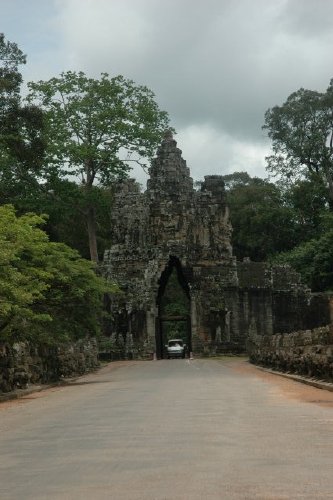 |
Bridge over the moat to Angkor Thom |
The gateways themselves are 3.5 by 7 m, and would originally have been closed with wooden doors. The south gate is now by far the most often visited, as it is the main entrance to the city for tourists. The city lies on the right bank of the river Siem Reap, a tributary of Tonle Sap, about a quarter of a mile from the river. The south gate of Angkor Thom is 7.2 km north of Siem Reap, and 1.7 km north of the entrance to Angkor Wat. The walls, 8 m high and flanked by a moat, are each 3 km long, enclosing an area of 9 km². |
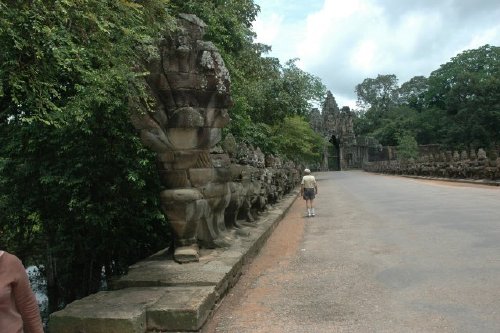 |
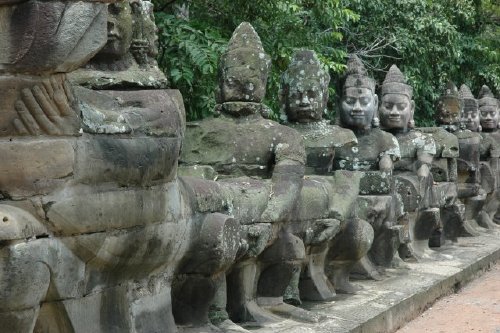 |
Mythic statues line the causeway over a moat leading to the south gate of Angkor Thom, literally called "Great City." The images represent a Hindu myth of creation called the Churning of the Sea of Milk. On one side of the causeway, fifty-four guardian deities (called "devas") pull the head of a mythical serpent or "naga." On the other side, fifty-four images of demon gods (called "asuras") push the tail of the serpent. The whipping motion of the serpent's body was said to churn the ocean and recreate the cosmos anew. The dancing female deities (each known as an "apsaras") were the first beings to emerge from the sea of creation. According to Hindu scriptures, these dancing divinities, whose name means "moving in water" in Sanskrit, were the first beings to emerge from the Churning of the Sea of Milk in the Hindu myth of creation. |
|
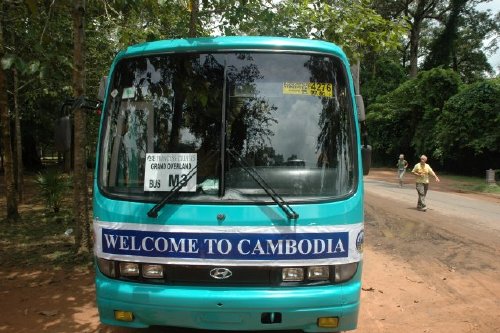 |
 |
The buses were quite comfortable ... fortunately |
Still more steps |
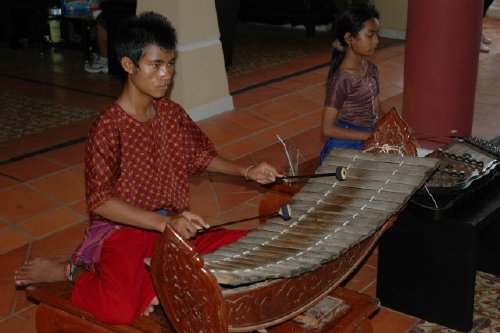 |
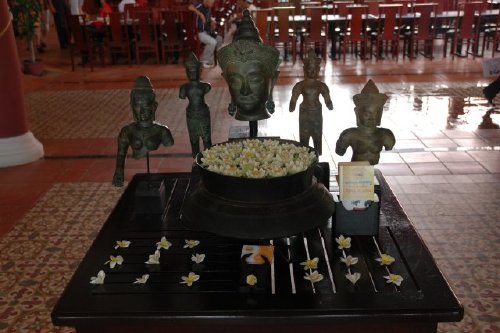 |
Ahhh ... lunch time in yet another 5 star hotel. AS you walk in, you are serenaded with traditional music. Here a Father and his 12 year old daughter perform in the lobby |
|
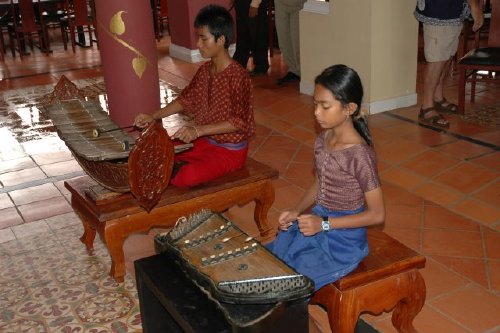 |
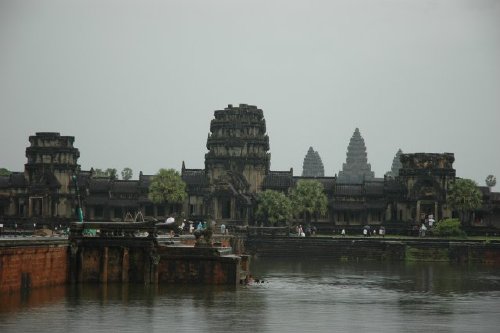 |
Absolute concentration |
After lunch, we head to Angkor Wat Temple itself. This is what I have been waiting for. Of course, it starts to pour rain now!!!! |
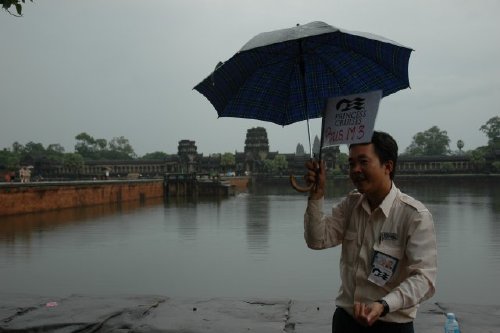 |
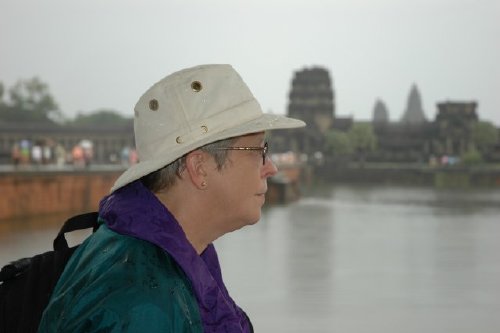 |
The guide tries to keep dry ... but good luck!!! We are soaked!!! |
Indiana Elsie ...literally "soaking up" what the Guide has to say. |
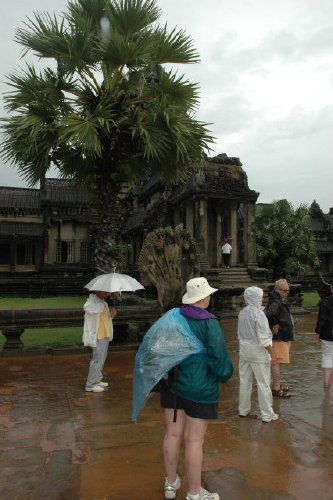 |
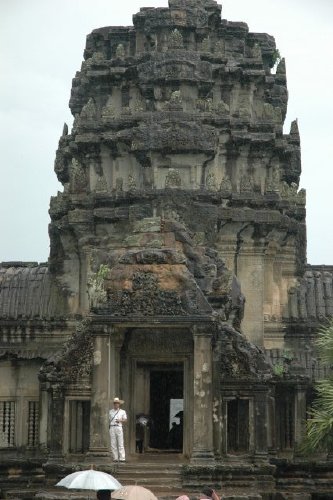 |
We did try to keep the back pack dry ... we sure went through the drinking water that day ... as well as the rain water!!! |
Entrance to the causeway to the Temple ... Like the Taj, you walk through the arch and see the Temple in front of you |
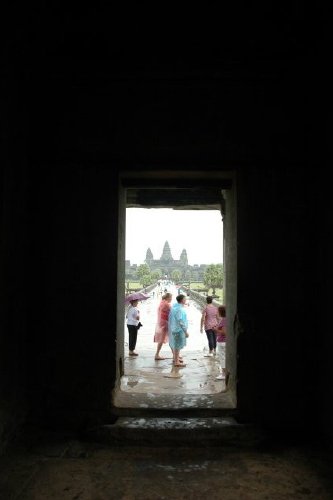 |
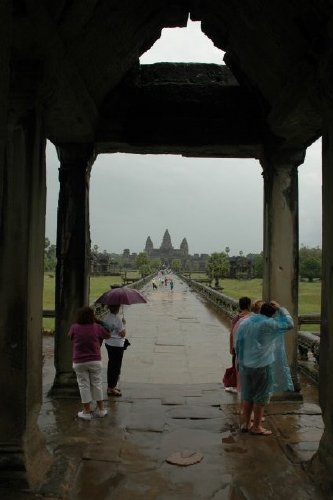 |
The temples of Angkor, built by the Khmer civilization between 802 and 1220 AD, represent one of humankind's most astonishing and enduring architectural achievements. From Angkor the Khmer kings ruled over a vast domain that reached from Vietnam to China to the Bay of Bengal. The structures one sees at Angkor today, more than 100 stone temples in all, are the surviving remains of a grand religious, social and administrative metropolis whose other buildings - palaces, public buildings, and houses - were built of wood and are long since decayed and gone. |
The Temple of Angkor Wat was dedicated to the Hindu God Vishnu by King Suryavarman II, who reigned between AD 1131 and 1150. The Temple was constructed over a period of 30 years, and illustrates some of the most beautiful examples of Khmer and Hindu art. Covering an area of about 81 hectares, the complex consists of five towers, which are presently shown on the Cambodian national flag. These towers are believed to represent the five peaks of Mount Meru, the Home of Gods and Center of the Hindu Universe. Angkor Wat features the longest continuous bas-relief in the world, which runs along the outer gallery walls, narrating stories from Hindu Mythology. With the decline of the Ancient Khmer Empire, Angkor Wat was turned into a Buddhist Temple and was continuously maintained, which helped its preservation. In 1992, the UNESCO World Heritage Committee declared the monument, and the whole city of Angkor, a World Heritage Sit |
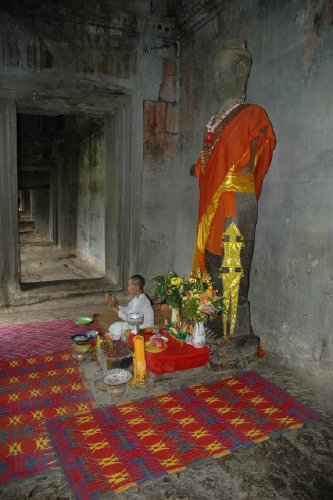 |
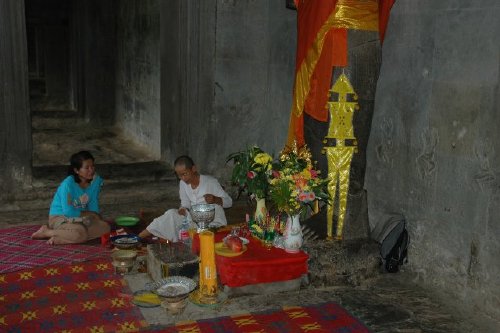 |
But, this still is a religious place that is being used all the time by the devout |
|
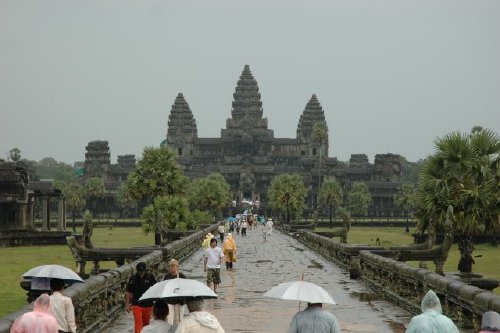 |
 |
Conventional theories presume the lands where Angkor stands were chosen as a settlement site because of their strategic military position and agricultural potential. Alternative scholars, however, believe the geographical location of the Angkor complex and the arrangement of its temples was based on a planet-spanning sacred geography from archaic times. Using computer simulations it has been shown that the ground plan of the Angkor complex – the terrestrial placement of its principal temples - mirrors the stars in the constellation of Draco at the time of spring equinox in 10,500 BC. While the date of this astronomical alignment is far earlier than any known construction at Angkor, it appears that its purpose was to architecturally mirror the heavens in order to assist in the harmonization of the earth and the stars. Both the layout of the Angkor temples and iconographic nature of much its sculpture, particularly the asuras (‘demons’) and devas (‘deities’) are also intended to indicate the celestial phenomenon of the precession of the equinoxes and the slow transition from one astrological age to another. |
It looks wet and cold here ... well wet it is but cold it isn't!!! |
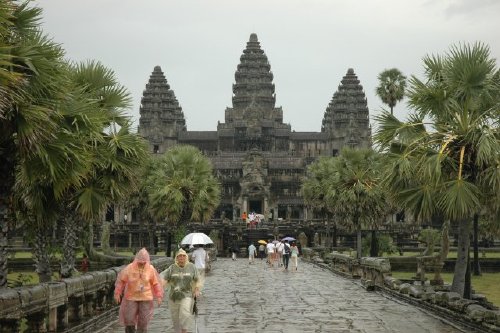 |
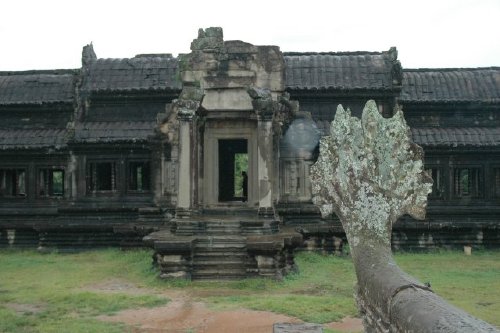 |
This is something I have always wanted to see!!! |
On either side of the causeway, there are more temples and building |
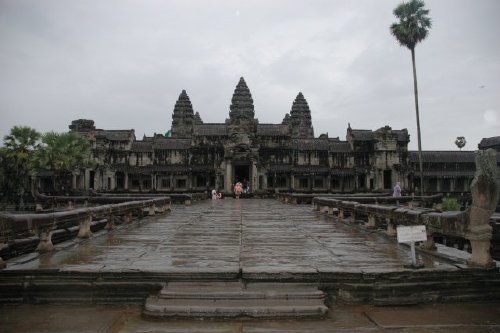 |
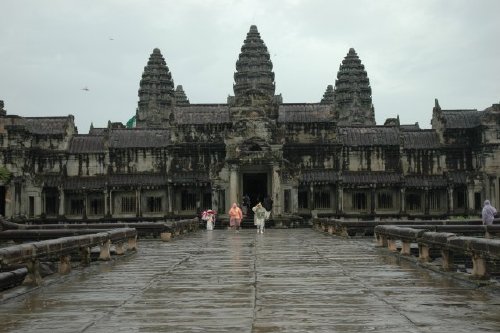 |
Closer and closer |
|
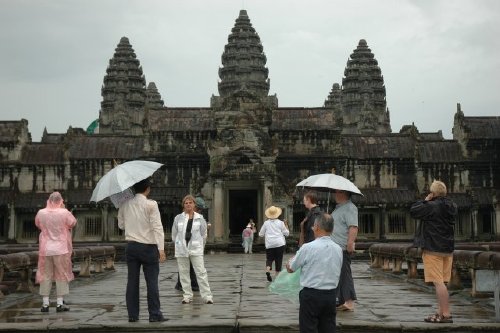 |
 |
The heavy monsoon rain has finished and now the humidity goes through the roof .. so to speak |
This picture is the left side of the more recognizable Angkor Wat Towers |
 |
 |
This is the right side of the towers |
Apparently in the high tourist season, pictures like this are impossible to get because of the crowds |
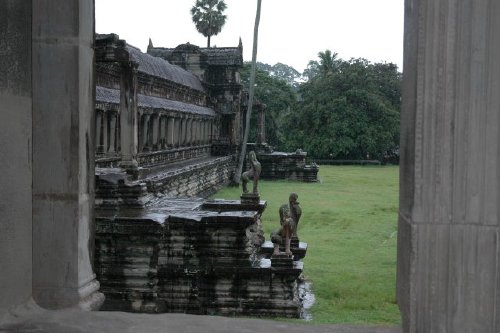 |
 |
More steps as you head inside |
|
 |
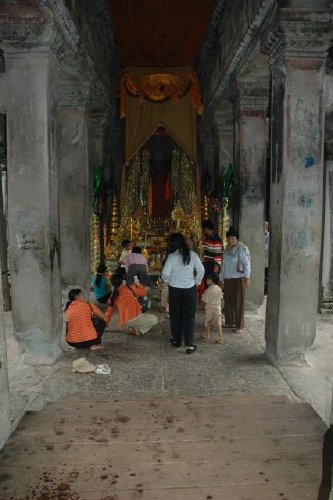 |
Again, this is an active shrine with religious services happening all the time |
The locals just ignore as best they can, all the interruptions |
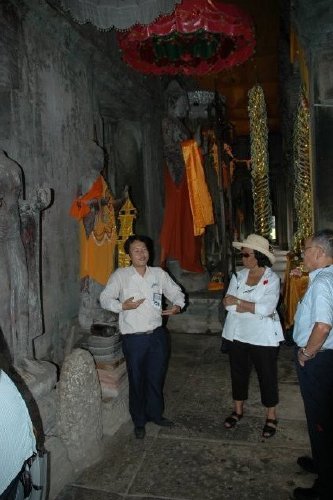 |
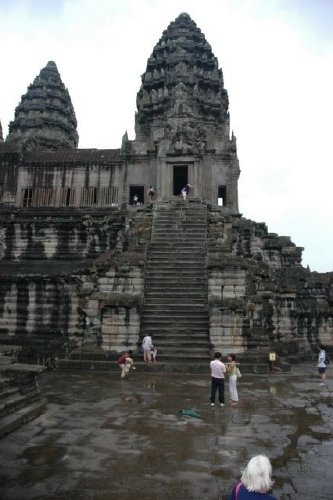 |
Just behind the Guide is a religious service going on ... no one seems to mind the noise distractions. Behind me, an other guide is also talking loudly |
This is the fourth level of the Wat. |
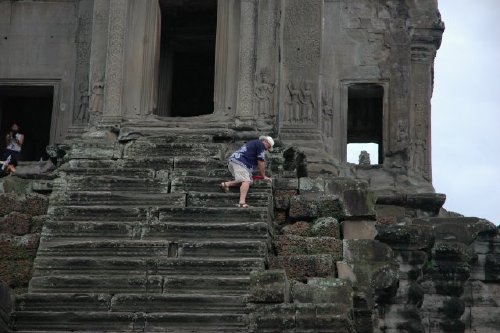 |
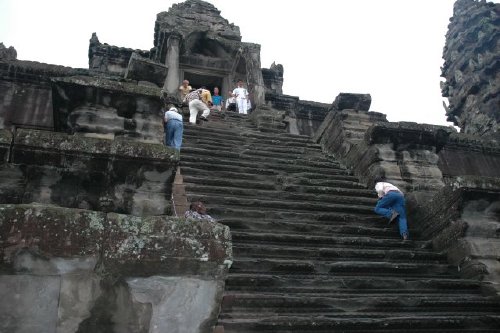 |
The only way up is ... climb those stairs or the ones on the left side of the Tower |
I don't know what is wrong with me, but as soon as I saw those stairs, I had to climb. |
 |
 |
We had probably climbed several hundred stairs by this time and what was a few more, I thought. You can see how steep they are. There is a wire rope that you can hand on to on the left side, if you can start before people start down. I waited about 5 minutes for a break and then gave up and climbed the right side. When you got to the top, you had to force your way through the crowds waiting to go down. I did not enjoy the climb very much and the thought that I had to climb down again nagged at me constantly |
And when you get there, the view back to the main gate is neat but .. |
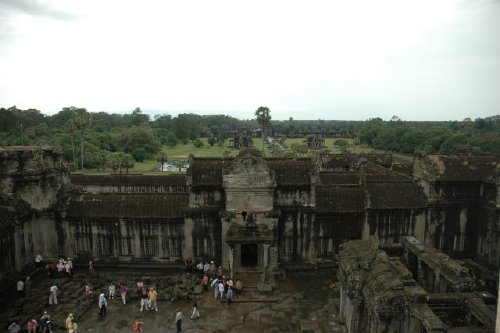 |
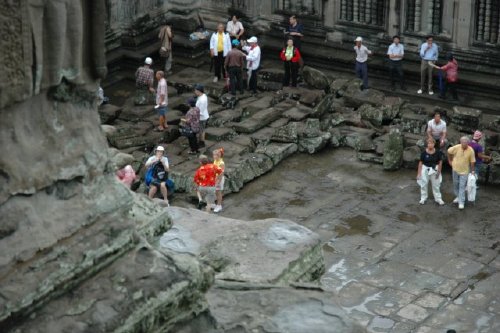 |
At least it wasn't raining, but the rocks are still wet and slippery |
This is Elsie who had the good sense to stay on the 3 level. I took this picture from the window in the picture below |
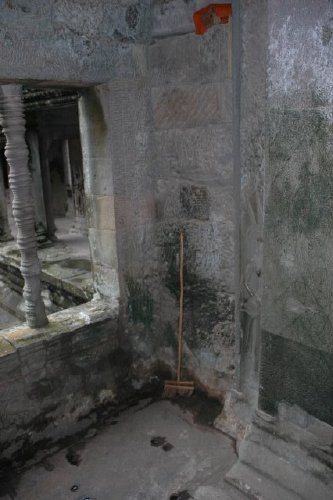 |
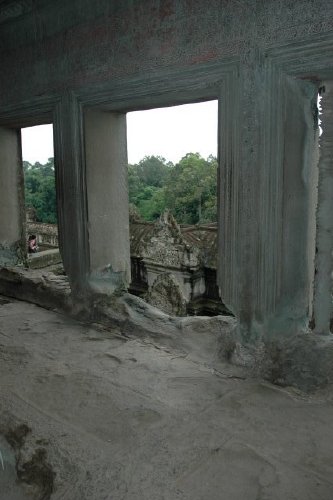 |
Not much here, but obviously they kept the place clean |
And yes ... it is straight down from that window with nothing to stop you |
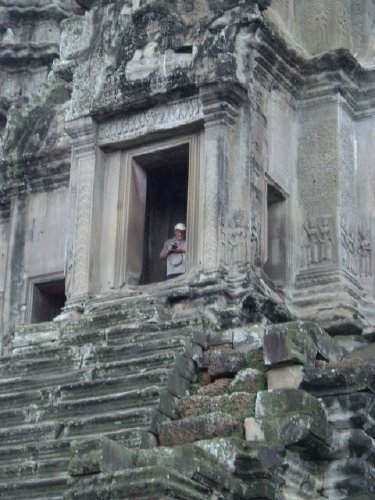 |
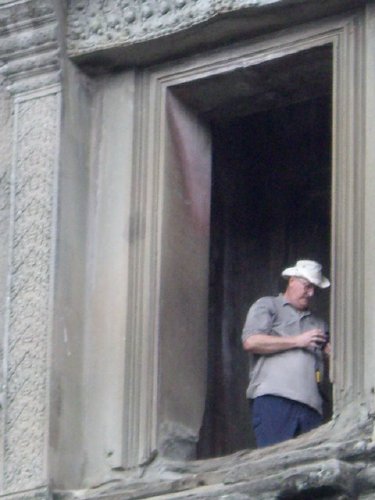 |
Elsie got busy with her telephoto lens |
One last look around and .... |
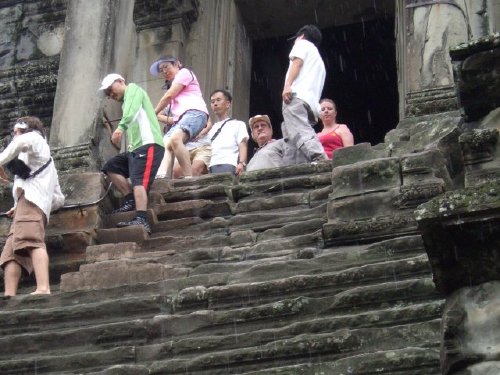 |
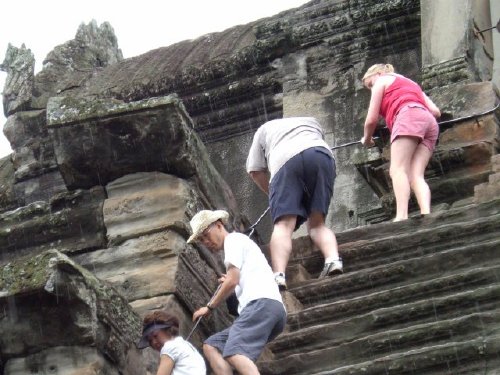 |
Getting in line to go down ... with my knees and after climbing so many stairs, this could get exciting |
Just starting down and guess what ... it starts to rain again |
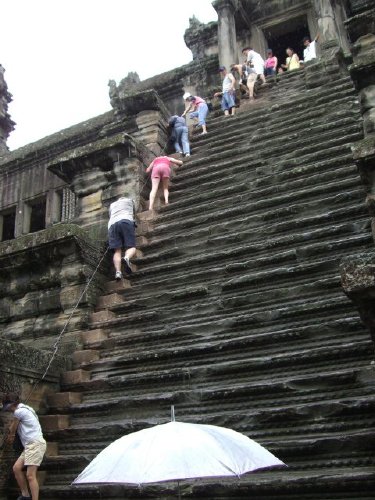 |
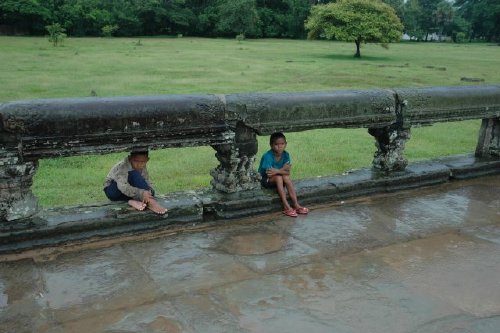 |
These stairs were steep and the rain made them really slippery. I was hanging on for dear life and not looking down ... ever. |
These kids had the right idea ... the railing along the causeway is big enough for them to hide underneath |
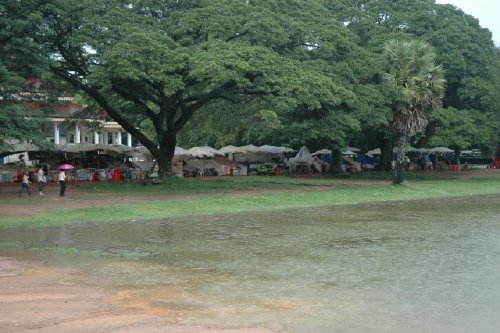 |
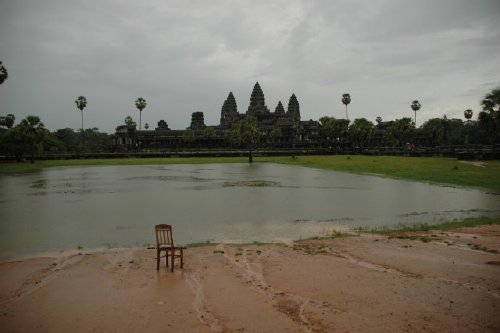 |
As always ... merchants selling tourist stuff |
Some how, this picture grabbed my attention ... I can just see Yo Yo Mah or Pinchas Zuckerman walking over and sitting down to play here. Just what the chair was doing there, I have no idea! |
 |
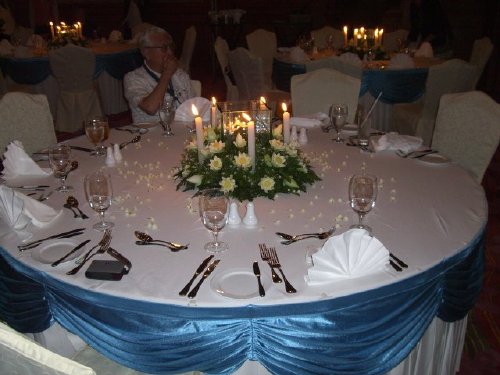 |
A last look at a beautiful sight. A childhood dream fulfilled |
That night, another banquet complete with entertainment at our hotel |
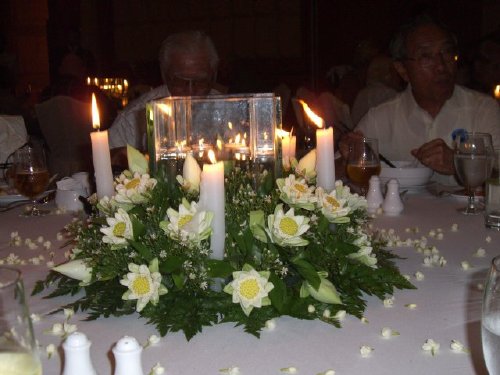 |
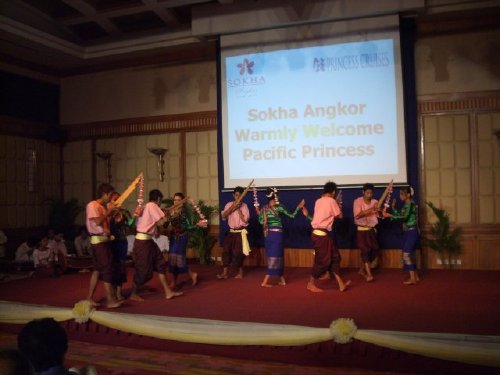 |
The food was a buffet that highlighted the local cuisine. I was not positive what we were eating all the time but it was sure good! |
The hotel, Sokha Angkor, put on the musician and dancers performance |
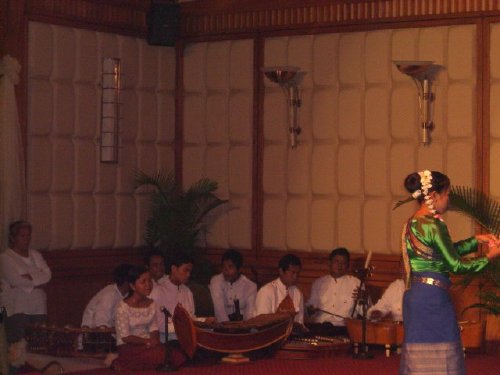 |
 |
This is the band and singer |
It wa a morality type play that was not explained very clearly to us |
 |
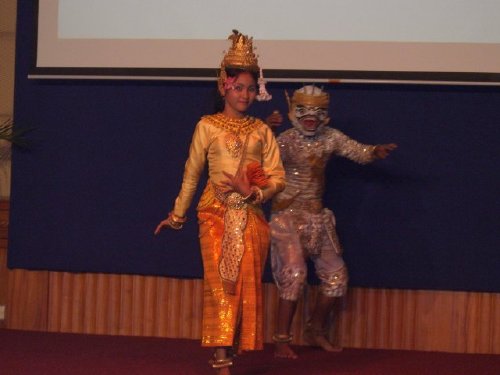 |
This is the heroine |
Being attacked from behind by a devil |
 |
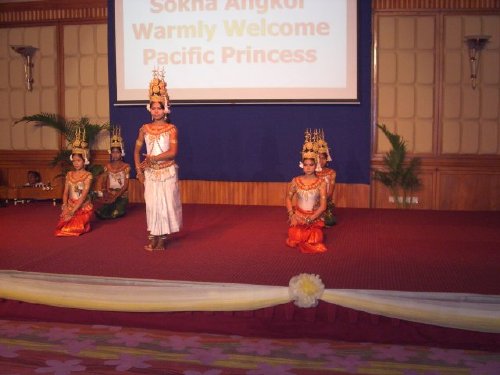 |
But she won and vanquished the devil |
With the help of her friends |
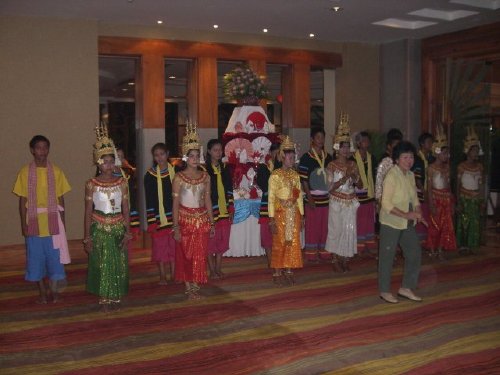 |
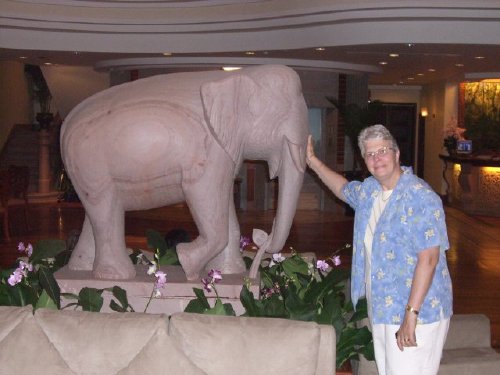 |
The total performance lasted almost an hour. Everyone quite enjoyed it. |
Again, Elsie and her elephants |
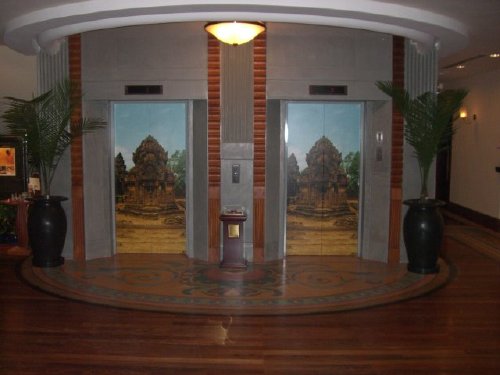 |
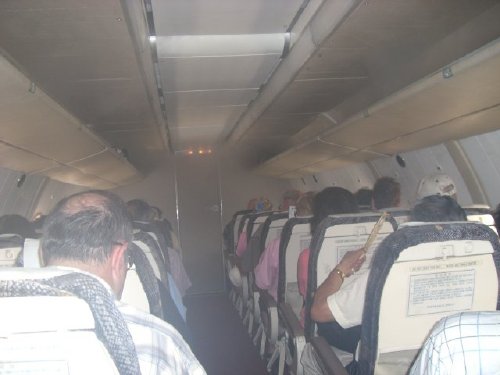 |
These are the doors to the elevator. Kind of neat with the pictures |
When we left Siem Reap to head to Phnom Penh, we flew in an old Russian prop plane. Just before we took off, the stewart warned us that although there was no A/C right now ... Gawd was it hot in that metal tube ... when we got up, they would turn it on. The only drawback was that the humidity was so high that once on, all you could see was smoke. He reassured us that it was not smoke ... only the A/C trying to work. Good thing he warned us though ... confidence of the passengers was not high at that point |
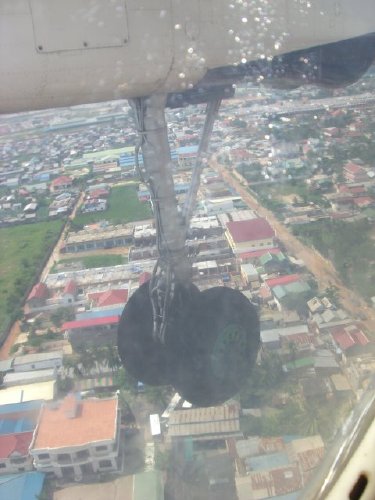 |
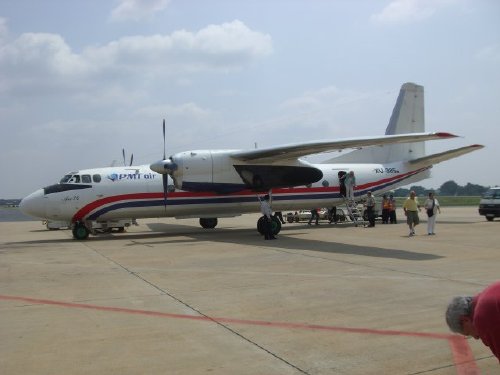 |
This is the view out our window. We were glad to see that the wheels actually came down when they were supposed to. |
The "Scare Cambodia" flight actually made it to Phnom Penh. I'll leave it to you plane buffs to recognize this antique |
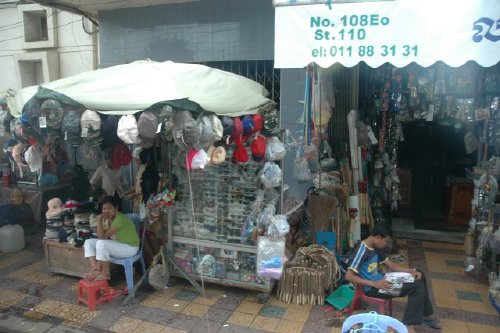 |
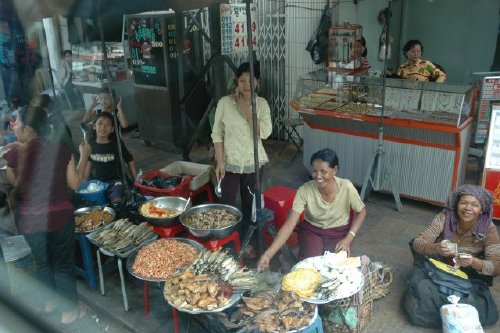 |
Local Market in Phnom Penh |
|
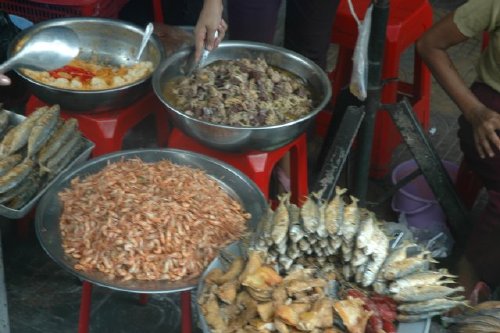 |
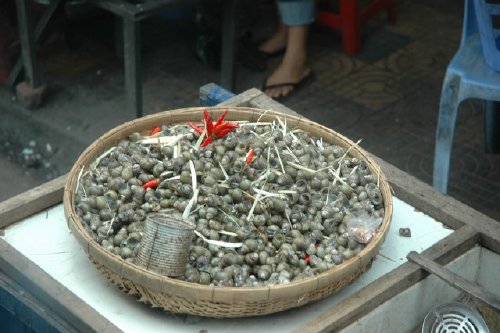 |
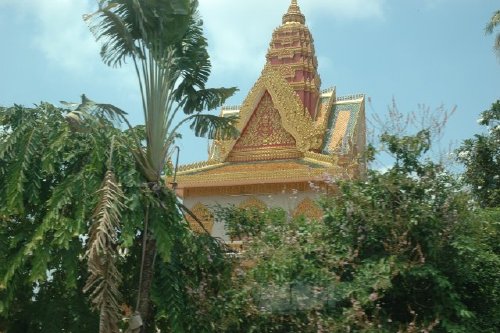 |
 |
The Royal Palace in Phnom Penh |
|
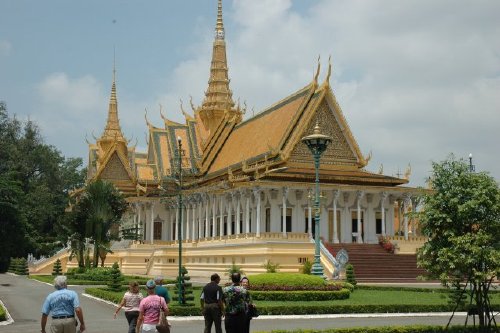 |
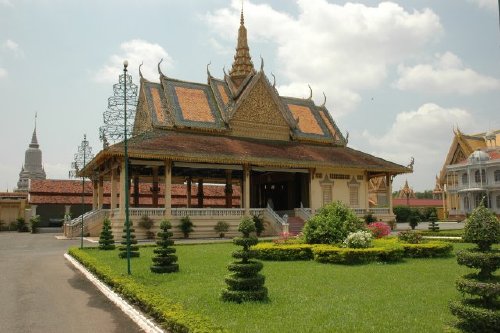 |
Throne Hall Royal Palace, Phnom Penh, Cambodia 1886-1919 |
The Royal Palace in Phnom Penh was constructed over a century ago to serve as the residence of the King of Cambodia, his family and foreign dignitaries, as a venue for the performance of court ceremony and ritual and as a symbol of the Kingdom. It serves to this day as the Cambodian home of King Norodom Sihamoni and former King Norodom Sihanouk. The Royal Palace complex and attached 'Silver Pagoda' compound consist of several buildings, structures and gardens all located within 500x800 meter walled grounds overlooking a river front park. |
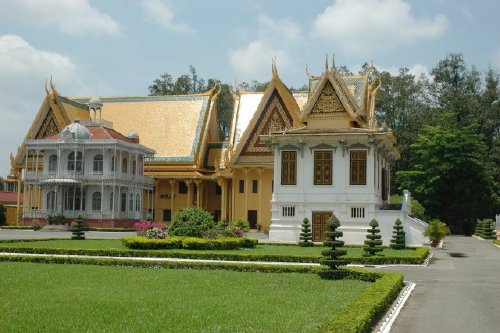 |
 |
Napoleon III Pavilion At first glance the Napoleon III Pavilion seems almost out-of-place, sitting like a European-style dollhouse amongst the imposing and distinctly Khmer-style buildings that surround it. The Pavilion was in fact the first permanent structure on the site of the Royal Palace. It was originally built for Empress Eugenie of France, wife of Napoleon III, in 1869 for use in the inauguration of the Suez Canal. |
It is constructed entirely of iron. In 1876 Emperor Napoleon III made a gift of the building to King Norodom of Cambodia. By fortunate happenstance, the royal emblem "N" emblazed on the doors and other parts of the building to honor the name of 'Napoleon' did not need to be altered when the pavilion was transferred to King Norodom. |
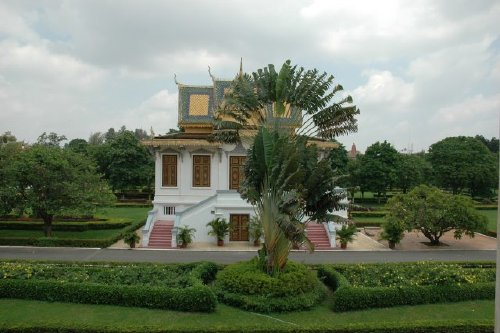 |
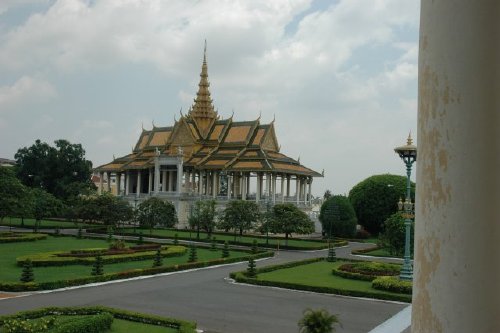 |
Hor Samran Phirun "The pavilion where one sleeps peacefully." Royal rest house and waiting area where the King waits to mount an elephant for Royal processions. Also built to house musical instruments and procession implements. Constructed in 1917. Currently housing a display of gifts from foreign heads of state. |
Moonlight Pavillion Royal Palace, Phnom Penh 1914 |
 |
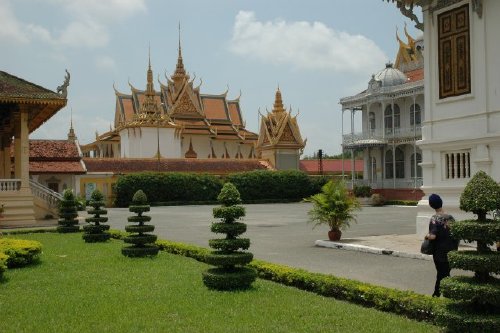 |
The Phochani Pavilion and open hall for dancing... currently used for Royal receptions |
|
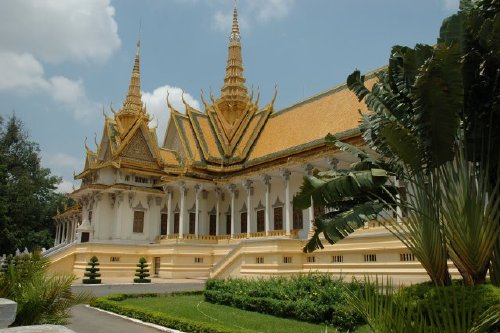 |
 |
Side view of the Throne Hall at the Royal Palace. |
|
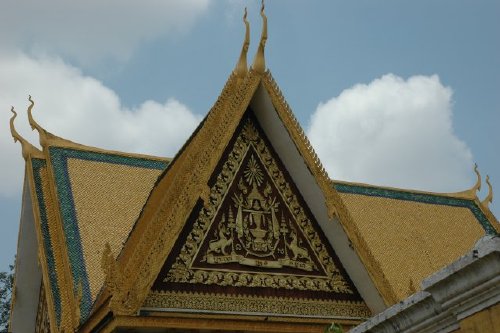 |
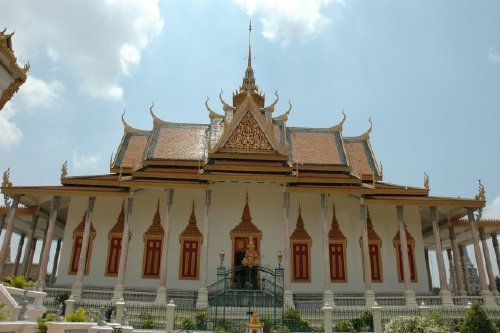 |
Khmer architecture |
The 'Silver Pagoda' sits next to the Royal Palace, separated by a walled walkway, but within the same larger walled compound. The Silver Pagoda's proper name is Wat Preah Keo Morokat, which means 'The Temple of the Emerald Buddha,' but has received the common moniker 'Silver Pagoda' after the solid silver floor tiles that adorn the temple building. The pagoda compound as a whole contains several structures and gardens, the primary building being the temple Wat Preah Keo Morokat and other structures including a library, various stupas, shrines, monuments, minor buildings and the galleries of the Reamker. |
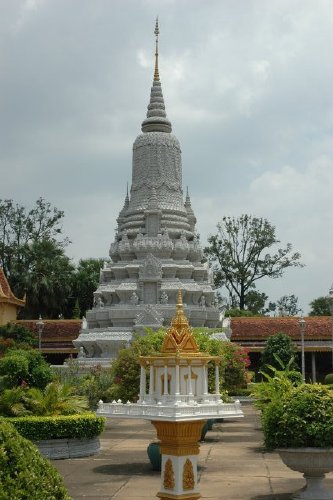 |
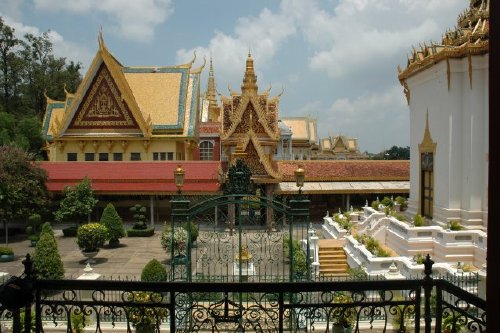 |
| At the northern area of the palace grounds is the Silver Pagoda. The original pagoda, built in 1866 by King Norodom, was, for the most part, made of wood. In 1962, it was expanded by Sihanouk. The name of the pagoda derives from the fact, that its floor is made of more than 5,000 silver blocks weighing more than 6 tons. When visiting the Silver Pagoda, one should not wear shorts or hats. Entrance fee is two US Dollars per person; anyone bringing a camera is charged another two Dollars; the extra fee for video cameras is five Dollars. The most important Buddha statue of the temple is, like in Bangkok's royal temple, an Emerald Buddha, which in this case is not made of emerald, but of Baccarat crystal. It dates back to the 17th century. Behind the Emerald Buddha is another Buddha statue made of 90 kilograms of gold and decorated with 9,584 diamonds. It was cast in 1906. |
|
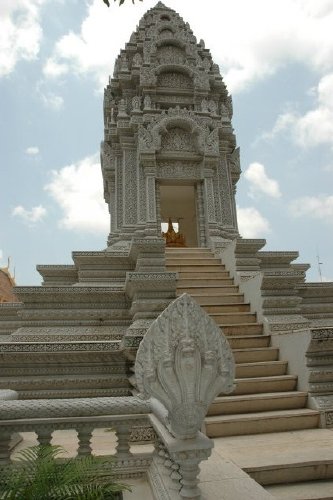 |
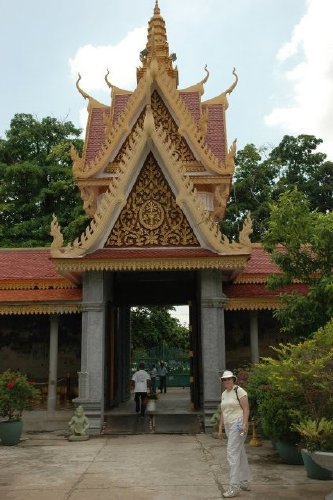 |
Stupa of Princess Kantha Bopha The memorial sanctuary of the beloved daughter of the former King Sihanouk. Princess Kantha Bopha passed in 1952 at the age of four, succumbing to leukemia. The stupa was built in 1960. |
Gate on the way out of the Royal Palace |
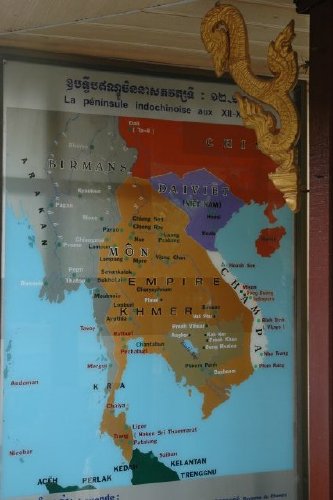 |
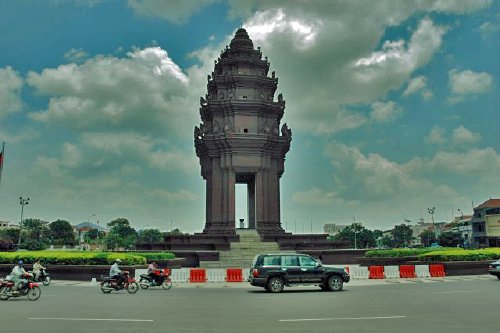 |
Independence Monument (At the intersection of Norodom and Sihanouk) The Independence Monument (Vimean Ekareach) was inaugurated in 1958 to celebrate Cambodia’s independence from foreign rule. It now also serves as a monument to Cambodia’s war dead. It is the site of celebrations and services on holidays such as Independence Day and Constitution Day. Trespassing onto the monument is illegal (sometimes). |
|
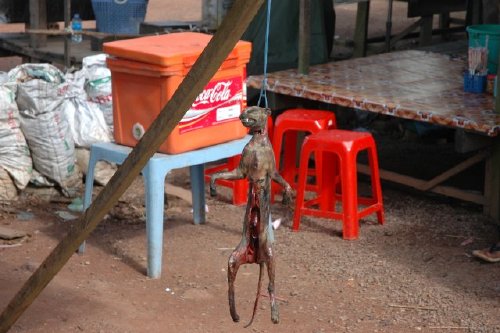 |
 |
On the bus back to the ship in Sihnoukville, we stopped for a cold drink at a restaurant. This little critter was hanging there, gutted, waiting to be someones dinner I guess. Never did find out just what kind of critter it was.. |
Countryside on the way to the ship |
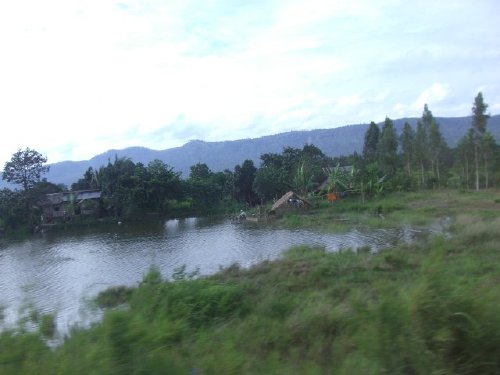 |
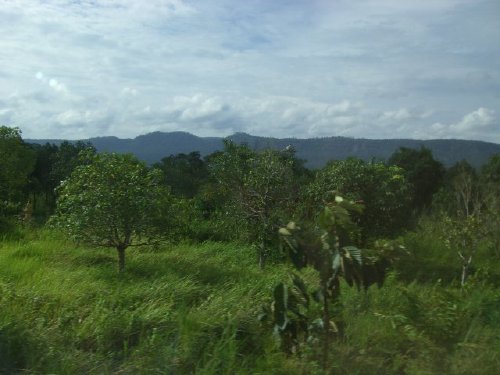 |
 |
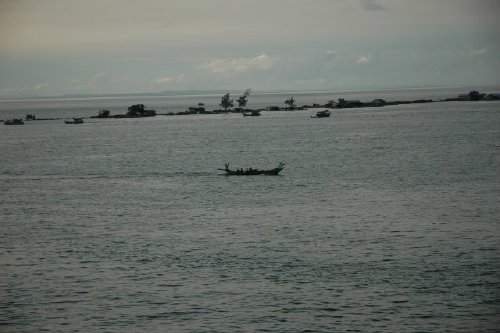 |
Finally back at the ship ... It was a fantastic 3 day adventure. One that i will never forget!!! |
Return to Angkor Wat Page
Return to India Page